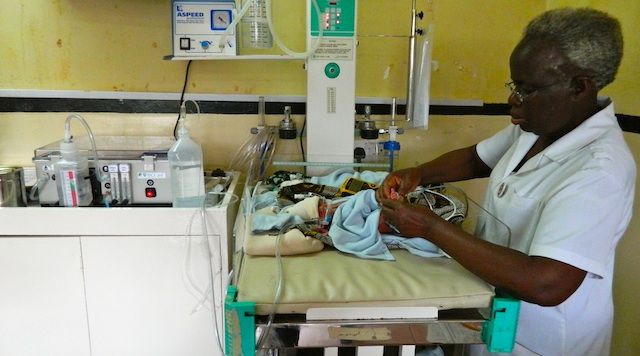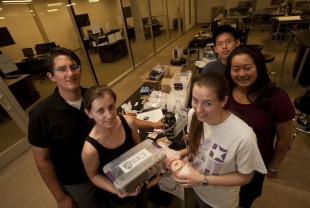Saving Lives at Birth funds low-cost bCPAP to help newborns in respiratory distress

A nurse at Queen Elizabeth Central Hospital in Blantyre, Malawi, fits the bCPAP device developed by Rice University students to an infant. The Saving Lives at Birth program has committed funding to help develop the device that aids newborns struggling with respiratory distress. (Photo by Jocelyn Brown)
Rice University’s low-cost, student-designed device that helps newborns in respiratory distress is one of three projects nominated this month to receive a grant of up to $2 million from the Saving Lives at Birth partners to speed deployment of the technology in Malawi in southern Africa.
Bubble continuous positive airway pressure — or bCPAP — devices are commonly used in the developed world to treat infants whose respiratory systems are underdeveloped or compromised by infection. However, at $6,000 each, the devices are often too expensive for hospitals in the developing world. The bCPAP device developed by Rice can be built for $160 and delivers the same therapeutic pressure as devices in hospitals in the developed world. Rice’s bCPAP device, a project in Rice’s Beyond Traditional Borders initiative, was developed at Rice’s Oshman Engineering Design Kitchen by seniors as their engineering design capstone project in 2010.
“We are very grateful for the opportunity to continue the important work we began with Saving Lives at Birth seed funding to evaluate and implement the low-cost bCPAP device in Malawi,” said Rebecca Richards-Kortum, Rice’s Stanley C. Moore Professor of Bioengineering and director of the Rice 360°: Institute for Global Health Technologies. “Preliminary data from our clinical trial at Queen Elizabeth Central Hospital in Blantyre, Malawi, suggest that our bCPAP device can significantly improve survival for infants struggling with respiratory distress. We look forward to bringing this life-saving device to all central and district hospitals in Malawi with transition-to-scale funding.”
Saving Lives at Birth is sponsored by the U.S. Agency for International Development, the government of Norway, the Bill & Melinda Gates Foundation, Grand Challenges Canada and the U.K.’s Department for International Development. Last year, Rice’s low-cost bCPAP device was one of 19 projects selected by Saving Lives at Birth for seed-grant funding. The device competed with more than 600 submissions. This year, Rice’s bCPAP device was among three of 14 applicants nominated to receive a larger “transition-to-scale” grant. The additional funds are intended to scale up the technology for widespread deployment in Malawi. Rice will now enter into negotiations before the award is finalized. The grants are typically worth $2 million.

From left, Rice alumni Michael Pandya, Jocelyn Brown, Katie Schnelle, Haruka Maruyama and Joseph Chang showed components of their bubble continuous positive airway pressure device, developed in 2010 to help infants recover from respiratory infections. Photo by Jeff Fitlow
With seed funding, Rice 360° and its partners, the University of Malawi, Baylor College of Medicine and 3rd Stone Design, evaluated the low-cost bCPAP device in a clinical trial at Queen Elizabeth Central Hospital this year, developed training programs, designed a commercial prototype and held a countrywide stakeholders meeting to gather feedback on the device. With transition-to-scale funding, the team, joined by MD Anderson Cancer Center, will build on this work to implement the device in all central and district hospitals in Malawi, develop a campaign to educate mothers about bCPAP and assess the device’s cost-effectiveness. An estimated 178,000 babies could be saved each year if the device is disseminated throughout Africa, Richards-Kortum said.
In February, original student design team member Jocelyn Brown, now a staff member at Rice 360°, was one of four representatives of academic institutions invited to the White House to present at an “Innovations in Global Health” event. Also on the original student design team were Rice alumni Michael Pandya, Joseph Chang, Haruka Maruyama and Katie Schnelle.
“This award really validates what we’ve already accomplished,” said Brown, who helped to administer the clinical study in Malawi and will return in August to complete the work. “We’re thrilled to be able to go back and tell the doctors and nurses we’ve been working with that we’re continuing, and that we can bring bCPAP to more hospitals.”
Earlier this month, Rice alumna Jordan Schermerhorn was on the road in Africa as the winner of a competition to travel on a reporting trip with Pulitzer Prize-winning New York Times columnist Nicholas Kristof. While in Malawi, Schermerhorn and Kristof visited Rice students who were “tasked with field-testing health technologies developed in the classroom.” In her blog for the New York Times, Schermerhorn also wrote about the clinical trial in Blantyre.


Leave a Reply